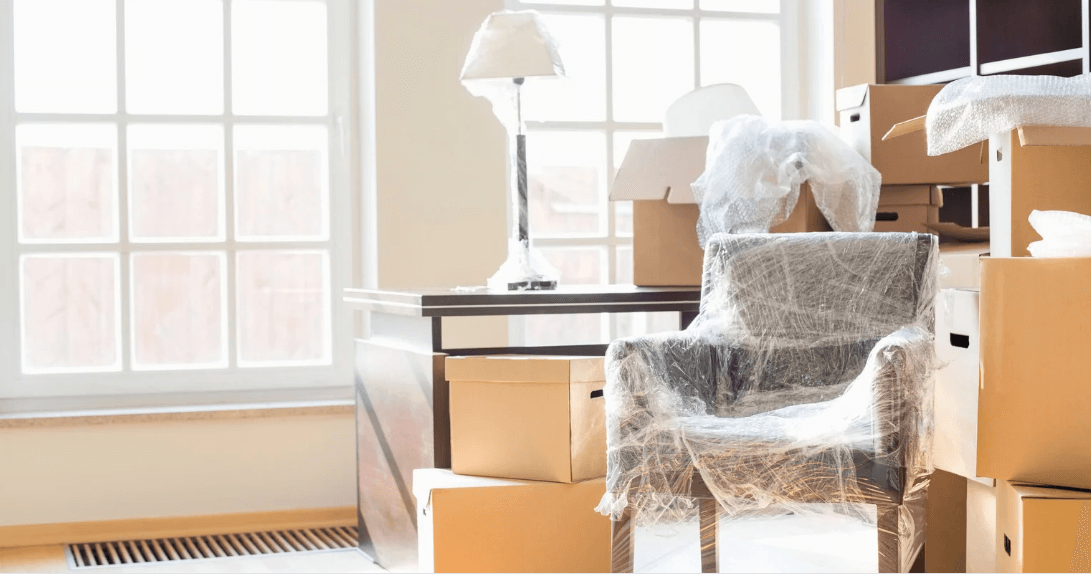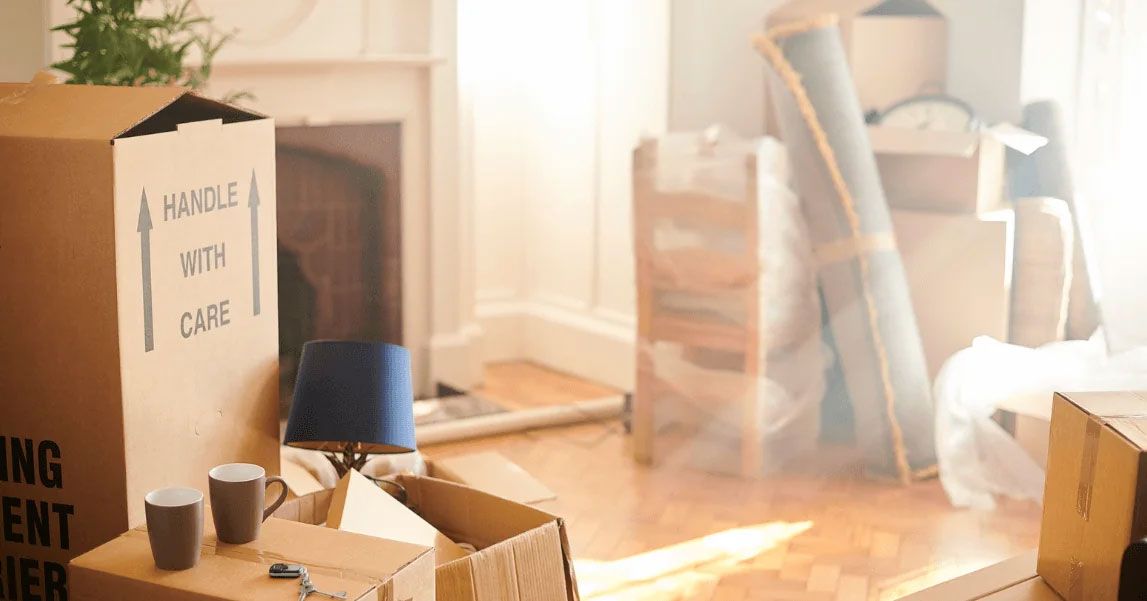When it comes to moving in Calgary, protecting your belongings is a top priority. But have you considered the need to protect your home as well? All the moving activities can potentially cause damage to your floors, walls, or doors. Read on for our top tips to ensure a smooth, damage-free transition to your new place in Calgary.
Calgary Movers’ Tips for Pre-Move Preparation
Before embarking on your moving journey in Calgary, preparing adequately is crucial. This involves gathering essential supplies, creating a protective plan, and scheduling the move to minimize disruption and potential damage.
Essential Supplies: What You Need Before You Start
Gathering the right moving supplies is the first step toward a successful move in Calgary. Quality boxes in various sizes, protective materials such as bubble wrap and packing paper, furniture pads, moving blankets, and plastic stretch wrap are all vital. You’ll need strong packing tape to secure and wrap the boxes. Don’t forget to have basic tools handy for disassembling any furniture.
What Moving Supplies to Gather:
- Quality Boxes: Have a variety of sizes at hand to accommodate all sorts of items. Small, medium, and larger boxes will cater to your diverse packing needs.
- Protective Materials: Items like bubble wrap and packing paper work great for wrapping fragile items and filling empty spaces in boxes.
- Furniture Pads and Moving Blankets: These can protect larger items like furniture and appliances from scratches and dings during the move.
- Plastic Stretch Wrap: This can wrap furniture and close doors and drawers.
- Strong Packing Tape: This will secure your boxes and protective wraps.
- Basic Tools: You’ll need basic tools for disassembling any furniture too large to move as-is.
Creating a Protective Plan: Outlining Steps to Safeguard Both Your Old and New Home in Calgary
A protective plan outlines the steps to safeguard your old and new homes. Start by taking photographs of your home before the move to have a record of its pre-move condition. Next, consider the path your Calgary movers will take and protect high-traffic areas with temporary floor and wall coverings. Protect corners with corner guards, and use door jamb protectors to protect doorways.
Scheduling: How to Plan Your Move to Minimize Disruption and Damage
Finally, scheduling your move in Calgary carefully is crucial. Avoid peak times and seasons if possible to ensure your Calgary movers can give your move the time and attention it deserves. Plan your packing to minimize the time items are in transit and vulnerable to damage. And remember, the more time you give yourself for the moving process, the less rushed you will be and, therefore, less prone to accidents.
Protecting Your Floors and Carpets
Protecting your floors is essential to the moving process. Different flooring materials require different types of protection, and it’s important to consider the best ways to apply those protections.
Material Selection: Types of Protective Materials for Different Flooring
When protecting your floors, the choice of material can make a substantial difference. Use adhesive plastic film or corrugated plastic sheets for hardwood or tile floors to prevent scratches and dings. These materials stick to the floor, providing a solid protective layer without slipping. For carpets, carpet film protectors are an ideal choice. They stick to the carpet, creating a smooth, slip-resistant surface that protects against spills and dirt.
Applying Floor Protection: Steps to Safeguard Your Floors
Follow these steps when applying protection to your floors:
- Clean the Floors: Begin by thoroughly cleaning your floors. This will prevent dirt and grit from getting trapped under the protective materials and scratching your floors.
- Measure and Cut the Protective Material: Measure the areas you want to protect and cut the necessary amount of protective material.
- Apply the Protective Material: Start from one end of the room and gradually apply the protective material, smoothing it out to prevent bubbles and wrinkles.
- Secure the Material: Ensure the protective material is secure and covers the entire floor area that will see traffic during the move.
- Check for Slips: Walk on the protective material to ensure it’s not a slipping hazard. If it moves or slides, you may need to add more adhesive or secure it with tape.
- Repeat for All Rooms: Repeat this process in all rooms where movers work.
Application Techniques: How to Apply Floor Protection Correctly
Applying floor protection is straightforward but requires attention to detail. For adhesive films, start at one end of the room and unroll the film across the floor, sticking it down as you go. Overlap layers by about an inch to ensure complete coverage. For corrugated plastic sheets, lay them flat and tape the edges together to create a continuous protective layer. With carpet film protectors, simply unroll the film across the carpet, pressing it down to ensure it sticks firmly.
Special Considerations: Handling Stairs and Thresholds
Stairs and thresholds present unique challenges for floor protection. It’s best to use a heavy-duty, non-slip plastic runner for stairs. Start at the top of the stairs and work your way down, securing the runner with tape. For thresholds, use a threshold ramp or a piece of plywood to create a smooth transition between surfaces, reducing the risk of tripping or damaging the threshold.
Safeguarding Walls and Doorways
The need for wall and doorway protection often goes overlooked in the moving process. However, these areas are vulnerable to scrapes, dings, and other moving-related damages. Ensuring their protection is crucial for maintaining your home’s appeal and value.
Padding Essentials: Choosing the Right Materials to Protect Walls
Several materials are available to protect your walls during a move. Adhesive foam tapes offer excellent protection for corners and edges. For flat wall sections, consider using temporary wall protectors or adhesive sheets that can be easily applied and removed. Drop cloths or moving blankets can also be draped over walls for additional protection.
DIY Solutions: Tips for Using Household Items for Extra Protection
If you’re looking for DIY solutions to protect your walls, consider using items commonly found around the house. Old bed sheets, towels, and blankets can be hung on walls to provide protection. Cardboard sheets can be cut and taped to walls to prevent scratches and dings. Remember, the goal is to create a barrier between your furniture and the wall.
Navigating Tight Spaces: How to Move Large Items Without Causing Damage
Moving large items through narrow spaces without causing damage can be challenging. Disassembling furniture as much as possible can make navigating tight spaces easier. Always plan your route beforehand and ensure you have enough help to move large items. Using furniture sliders can also reduce friction and make moving easier. Remember, it’s not about speed but careful maneuvering to avoid damage.

Furniture and Fixture Protection
Protecting your furniture and fixtures during a move is paramount to maintaining their condition and value. This entails using effective wrapping techniques, employing safe strategies for moving heavy items and securing built-ins, chandeliers, and other fixtures.
Wrapping Techniques: How to Properly Wrap Furniture to Prevent Damage
Proper wrapping can significantly minimize the risk of damage to your furniture. Start by removing any removable parts like drawers and cushions. Then, use moving blankets or pads to cover the furniture completely, securing them with plastic stretch wrap. For corners and fragile parts, use bubble wrap for additional protection. Remember to wrap each piece individually and not use tape directly on the furniture to prevent any damage to the finish.
Moving Heavy Items: Strategies to Move Heavy Furniture Safely
Moving heavy items safely requires careful planning and the right equipment. Furniture sliders can be a great help in moving heavy furniture across rooms in your Calgary home without damaging the floors. For stairs, consider using a moving dolly or a stair roller. Additionally, lifting straps can distribute the weight more evenly and reduce the strain on your back. Always remember to lift with your legs, not your back, and avoid twisting your body while lifting or carrying heavy items.
Protecting Fixtures: Ensuring Built-ins, Chandeliers, and Other Fixtures are Secure
Built-ins, chandeliers, and other fixtures require special attention during a move. Make sure that built-ins are securely fastened and that any doors or drawers are locked or taped shut. For chandeliers and other hanging fixtures, consider removing them and packing them separately, if possible. If removal is not an option, shield them with bubble wrap and secure them with ties to prevent swinging. Always remember to mark the boxes containing fixtures as fragile to alert your Calgary movers.
Exterior Precautions
Ensuring the exterior of your home is prepared for moving day is equally important to safeguarding the interior. The following sections provide a guide to maintaining clear pathways, preparing for unpredictable weather, and positioning the moving vehicle to prevent property damage.
Pathway Clearing: Ensuring Clear and Safe Pathways for Moving
A crucial aspect of move-prep is ensuring clear and safe pathways from your house’s entrance to the moving vehicle. Remove all potential trip hazards, such as gardening tools, toys, or loose paving stones. Trim overgrown vegetation that might obstruct the path. Remember, a clear path facilitates the moving process and significantly reduces the risk of accidents and damage to your possessions.
Weather Considerations: Preparing for Unpredictable Calgary Weather
The weather in Calgary can be unpredictable. Monitor the weather forecast in the run-up to your moving day, and make contingency plans for inclement weather, such as rain or snow. If bad weather is expected, clear pathways of snow or ice and lay down salt or sand to increase traction. Additionally, consider using waterproof coverings to protect your belongings during transport.
Securing the Moving Vehicle: Placement and Parking to Prevent Property Damage
The placement and parking of the moving vehicle are crucial to prevent potential damage to your property. The vehicle should be parked close to the house without encroaching on lawns or flower beds. Ensure the parking area is level and firm to support the vehicle’s weight. If the vehicle is left overnight, it should be secured to prevent theft, and parking regulations should be followed. Always remember safety and property protection are paramount during the moving process.
Calgary Movers’ Considerations for Post-Move
After your move in Calgary, assessing your belongings and old residence for potential damage is essential. It helps ensure everything is clean and tidy and provides your movers with feedback to improve future moves.
Damage Assessment: How to Check for and Document Any Damage
Once all items are moved, conduct a thorough walk-through of your old home and inspect each item in your new home for any possible damage. For this exercise, it’s advisable to have a checklist of all items and their conditions before the move. Compare this with their current state. If there are any discrepancies, take photos as proof and document the extent and nature of the damage in detail. This information will be crucial if you want to claim compensation from your movers or insurance company.
Final Clean-Up: Tips for Leaving Your Old Place in Calgary in Good Condition and Settling into the New One
Cleaning your old home in Calgary is a sign of respect for the new occupants and is often a requirement in rental agreements. Focus on high-traffic areas like the kitchen and bathroom. If possible, hire a professional cleaning service for a thorough job. As for your new home, cleaning before unpacking is easier and more effective. Again, focus on the kitchen and bathroom first, then proceed to other areas as you unpack.
Partner with Matco’s Calgary Movers Today
A successful house move is a well-planned move. From protecting your belongings to ensuring smooth load-in and load-out strategies, each step plays a pivotal role in minimizing damage and stress. Post-move considerations such as damage assessment, clean-up, and providing feedback also contribute to a seamless moving experience. Remember, your Calgary movers are your partners in this process – effective communication and cooperation with them can make all the difference. Whether you’re moving a few blocks away or to a different city, these strategies will help protect your belongings and the integrity of your home.
Ready to make your move? Whether you’re heading to a new house in Ontario, a downtown Calgary apartment, or anywhere in between, Matco’s team of expert Calgary movers is ready to help. Our suite of customizable moving services is designed to cater to your specific needs and budget. Contact us today, and let us make your next move smooth.


